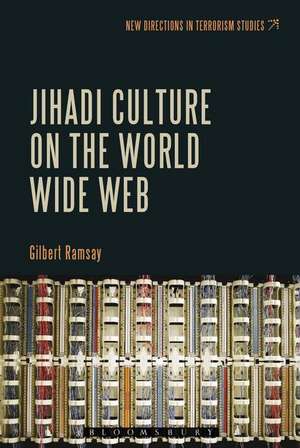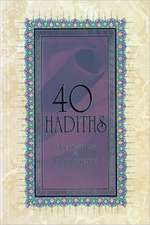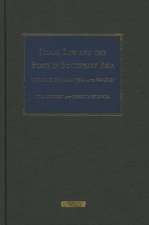Jihadi Culture on the World Wide Web: New Directions in Terrorism Studies
Autor Dr. Gilbert Ramsayen Limba Engleză Paperback – 17 iun 2015
| Toate formatele și edițiile | Preț | Express |
|---|---|---|
| Paperback (1) | 257.41 lei 43-57 zile | |
| Bloomsbury Publishing – 17 iun 2015 | 257.41 lei 43-57 zile | |
| Hardback (1) | 891.10 lei 43-57 zile | |
| Bloomsbury Publishing – 4 dec 2013 | 891.10 lei 43-57 zile |
Preț: 257.41 lei
Preț vechi: 331.13 lei
-22% Nou
Puncte Express: 386
Preț estimativ în valută:
49.25€ • 51.56$ • 40.76£
49.25€ • 51.56$ • 40.76£
Carte tipărită la comandă
Livrare economică 07-21 aprilie
Preluare comenzi: 021 569.72.76
Specificații
ISBN-13: 9781501307676
ISBN-10: 1501307673
Pagini: 272
Ilustrații: 5 halftone illus
Dimensiuni: 152 x 229 x 14 mm
Greutate: 0.36 kg
Editura: Bloomsbury Publishing
Colecția Bloomsbury Academic
Seria New Directions in Terrorism Studies
Locul publicării:New York, United States
ISBN-10: 1501307673
Pagini: 272
Ilustrații: 5 halftone illus
Dimensiuni: 152 x 229 x 14 mm
Greutate: 0.36 kg
Editura: Bloomsbury Publishing
Colecția Bloomsbury Academic
Seria New Directions in Terrorism Studies
Locul publicării:New York, United States
Caracteristici
Offers policymakers and researchers a new way of thinking about violent radicalization on the Internet
Notă biografică
Gilbert Ramsay works at the Centre for the Study of Terrorism and Political Violence at the University of St. Andrews, UK. An Arabic speaker, he has previously written reports on terrorism and the Internet for the United Nations and the European Union.
Cuprins
AcknowledgementsChapter 1: Terror on the Internet?Chapter 2: Alternative Media, and its AlternativesChapter 3: Jihadi Content on the Word Wide WebChapter 4: Jihadi Forums in their Own WordsChapter 5: Disagreeable DisagreementsChapter 6: Being a Jihadi on the InternetChapter 7: Some other 'Jihadi' Consumption Cultures: Crusaderism, War Porn, ShockChapter 8: Jihadism between Fantasy and Virtuality: A Tentative ConclusionGlossary of Arabic TermsBibliographyIndex
Recenzii
This comprehensive, forensic analysis of 'Jihadi' content on the Internet is of great help in understanding and assessing the related security threat. Gilbert Ramsay makes a compelling case for drawing a clear distinction between on-line and off-line activity. He looks deeply into the nature of 'salafi-jihadist' material on the web, and offers an interesting and novel take on the possible drivers behind its production and consumption.
This is a refreshing, distinctive and fascinating book. Gilbert Ramsay takes us a major step forward in terms of how we can and should think about the role the internet plays in modern terrorism.
In view of the recent Boston marathon bombings in the US and public murder of a serving British soldier in Woolwich UK, this book is a timely reminder of the necessity to further examine and narrow the debate regarding the potentially devastating effects of online violent radicalization. This authoritative research and analysis is important for policy makers and practitioners alike, particularly in view of their tendency to introduce potential knee-jerk legislation that risks infringing upon individual laws that extend to private access and use of the Internet. This book provides a nuanced perspective of the issues related to online radicalization, addressing the over emphasis and inconsistencies that have unfortunately plagued this particular field of study.
Theoretically sophisticated and empirically rich, Ramsay's text is a fresh and distinctive contribution to debates on the intersections of terrorism and the Internet and is thus recommended. Acting as an antidote to media and policymakers' assumptions that 'the Internet' is 'responsible' for much contemporary terrorism, his analysis is critical in the best sense: thoughtfully critiquing the literature produced in this area to-date and grappling with its inconsistencies. The embedding of online jihadism as a particular (sub-)cultural practice consistent with contemporary cultural and new media theory, is an additional noteworthy aspect of the analysis.
Drawing from a wealth of original Arabic-language primary sources, [Gilbert Ramsay's] book makes a novel and highly valuable contribution to the debates surrounding violent radicalization online.
Ramsay (Centre for Terrorism and Political Violence, St. Andrews, UK) makes a significant contribution to the understand of terrorism on the web. Utilizing a critical perspective, Ramsay considers what it means to read and participate online and, in doing so, calls into question much of the conventional wisdom about how individuals are radicalized in cyberspace. Here he suggests that Jihadi readers might try out and develop ideas in cyberspace and thus he cautions against taking everything found in such fora at face value. He also shows that many of the most radical sites have very small audiences. This work, based on his doctoral dissertation, presents extensive empirical data on the size of Jihadi audiences in different fora, participation rates, and modes of discourse. The work contains original translations and excerpts from existing online fora, along with the author's interpretation and commentary. This work deserves to be widely read and serves as the seminal book for understanding the phenomenon of Jihadi's in the virtual world. This work could very well impact the development of current counter-terrorism policies in cyberspace by the US and its allies. Summing Up: Highly recommended. All readership levels.--
This is a refreshing, distinctive and fascinating book. Gilbert Ramsay takes us a major step forward in terms of how we can and should think about the role the internet plays in modern terrorism.
In view of the recent Boston marathon bombings in the US and public murder of a serving British soldier in Woolwich UK, this book is a timely reminder of the necessity to further examine and narrow the debate regarding the potentially devastating effects of online violent radicalization. This authoritative research and analysis is important for policy makers and practitioners alike, particularly in view of their tendency to introduce potential knee-jerk legislation that risks infringing upon individual laws that extend to private access and use of the Internet. This book provides a nuanced perspective of the issues related to online radicalization, addressing the over emphasis and inconsistencies that have unfortunately plagued this particular field of study.
Theoretically sophisticated and empirically rich, Ramsay's text is a fresh and distinctive contribution to debates on the intersections of terrorism and the Internet and is thus recommended. Acting as an antidote to media and policymakers' assumptions that 'the Internet' is 'responsible' for much contemporary terrorism, his analysis is critical in the best sense: thoughtfully critiquing the literature produced in this area to-date and grappling with its inconsistencies. The embedding of online jihadism as a particular (sub-)cultural practice consistent with contemporary cultural and new media theory, is an additional noteworthy aspect of the analysis.
Drawing from a wealth of original Arabic-language primary sources, [Gilbert Ramsay's] book makes a novel and highly valuable contribution to the debates surrounding violent radicalization online.
Ramsay (Centre for Terrorism and Political Violence, St. Andrews, UK) makes a significant contribution to the understand of terrorism on the web. Utilizing a critical perspective, Ramsay considers what it means to read and participate online and, in doing so, calls into question much of the conventional wisdom about how individuals are radicalized in cyberspace. Here he suggests that Jihadi readers might try out and develop ideas in cyberspace and thus he cautions against taking everything found in such fora at face value. He also shows that many of the most radical sites have very small audiences. This work, based on his doctoral dissertation, presents extensive empirical data on the size of Jihadi audiences in different fora, participation rates, and modes of discourse. The work contains original translations and excerpts from existing online fora, along with the author's interpretation and commentary. This work deserves to be widely read and serves as the seminal book for understanding the phenomenon of Jihadi's in the virtual world. This work could very well impact the development of current counter-terrorism policies in cyberspace by the US and its allies. Summing Up: Highly recommended. All readership levels.--























